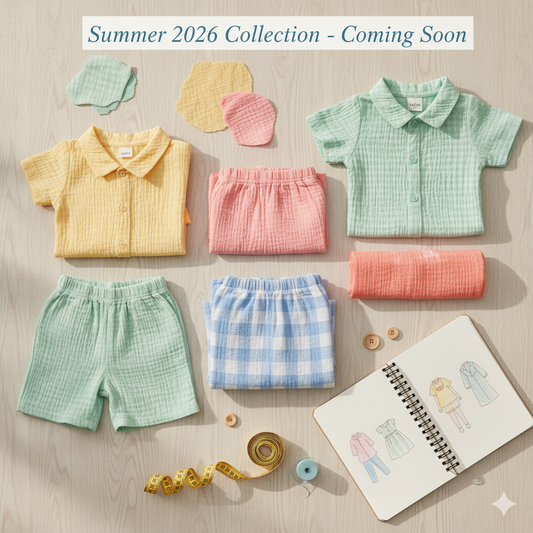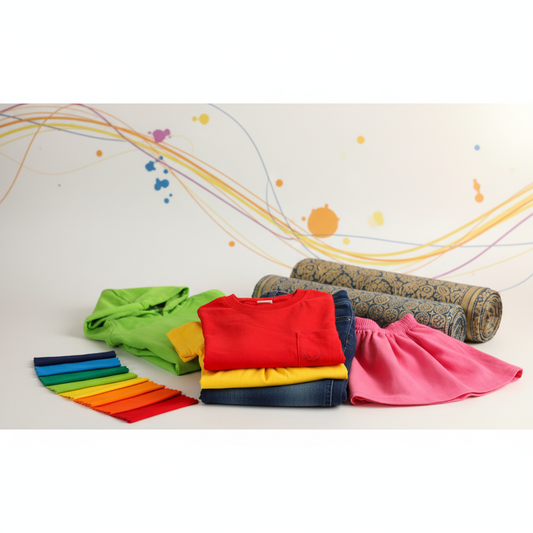
How to Teach Your Child to Dress Independently (Save Time & Build Confidence)
When your kids are small, around ages one to three, dressing them is easy and even fun. You pick out adorable little outfits, they sit still (mostly!), and those tiny socks and onesies make you smile. But then something changes.
Around age three or four, everything shifts. They start moving constantly. They squirm, they run away mid-outfit, they suddenly have opinions about which shirt to wear. And if you have more than one child? Multiply that chaos by two, three, or more.
Picture this: It's a regular school morning. You're trying to get one child dressed while another is taking off the pajamas you just helped them out of. You're already running late, lunches aren't packed, and you haven't even had your coffee yet.
Or imagine this: You have a family function to attend. You've bathed the kids, their hair is combed, and they look perfect. But now comes the battle of actually getting them dressed in their nice clothes. Twenty minutes of wrestling, negotiating, and near-tears later (yours and theirs), you finally leave the house frazzled and late.
Now imagine a different scenario: You lay out their clothes, give them a gentle reminder, and they dress themselves while you get ready in peace. You arrive on time, calm, and your kids beam with pride at what they've accomplished.
That's the power of teaching your child to dress independently.
Today, I'm sharing the exact 5-step method we use to teach kids self-dressing skills. It's changed our mornings completely, and it can change yours too.
Why Teaching Self-Dressing Actually Matters
Before we dive into the how, let's talk about why this skill is so important. It's not just about convenience for parents (though that's definitely a bonus!).
Benefits for Your Child
Builds Confidence and Independence
When a child successfully puts on their own shirt or shoes, they experience genuine accomplishment. That "I can do it myself!" feeling is powerful and builds self-esteem that extends far beyond getting dressed.
Develops Fine Motor Skills
Every button fastened, zipper pulled, and snap closed strengthens hand-eye coordination and finger dexterity. These same skills help with writing, using utensils, and countless other daily tasks.
Encourages Decision-Making
Choosing what to wear (within your guidelines) helps children develop autonomy and learn to make age-appropriate decisions. It's a safe space to practice having preferences and expressing them.
Prepares Them for School
Teachers cannot dress 25 children for outdoor play, gym class, or after bathroom breaks. Kids who can dress themselves adapt better to school routines and feel more capable in the classroom environment.
Creates a Sense of Responsibility
When children are responsible for their own clothing, they begin to take ownership. They become more aware of keeping clothes clean, putting dirty items in the hamper, and taking care of their belongings.
Benefits for You as a Parent
Saves Precious Time
Those 15-30 minutes you spend wrestling kids into clothes every morning? Imagine having that time back for a peaceful breakfast, packing lunches, or simply enjoying your coffee while it's still hot.
Reduces Daily Battles
The pushing, pulling, "just hold still for one second!" frustration decreases dramatically when kids dress themselves. Less conflict means happier mornings for everyone.
Creates Peaceful Morning Routines
Instead of starting your day with stress and rushing, you can have a calm, cooperative morning where everyone moves through their routine smoothly.
More Independence During Events
Family functions, playdates, sleepovers, swimming lessons - all become easier when your child can change themselves without constant assistance.
Lays Foundation for Life Skills
Self-dressing is just the beginning. Children who master this skill early often progress more easily to other self-care tasks like brushing teeth, bathing, and eventually managing their own schedules.
The investment you make in teaching this skill now pays dividends every single day for years to come.
The 5-Step Method to Teach Kids to Dress Themselves
Step 1: Start With the Right Age and Clothing (Ages 2.5-4)
When to Begin
Most children are ready to start learning self-dressing between 2.5 and 4 years old. Every child develops differently, so look for these readiness signs rather than focusing solely on age:
- They try to pull off their own socks or shoes
- They show interest in choosing their clothes
- They can follow simple two-step instructions
- They're starting to say "me do it!" or "I can do it myself!"
- They can stand without support and balance on one foot briefly
Set Them Up for Success
The clothing you choose during the learning phase makes all the difference. This isn't the time for complicated outfits:
- Choose elastic waistbands - Pull-on pants and shorts are infinitely easier than buttons and zippers
- Pick loose-fitting t-shirts - Wide neck openings that won't get stuck on their head
- Use slip-on shoes or velcro - Save laces for much later (usually age 6+)
- Avoid complicated fastenings - Skip overalls, belts, and anything with tiny buttons
- Select tag-friendly clothes - Clear tags make it easier to identify front vs. back
Pro Tip: Simplify their entire wardrobe during the learning phase. Store fancy outfits with complicated buttons separately for occasions when you'll help them dress. Having a drawer full of easy-to-wear clothes removes obstacles and builds confidence faster.
Step 2: Break It Down Into Small, Manageable Tasks
Trying to teach your child to get fully dressed all at once is overwhelming for both of you. Instead, master one clothing item at a time.
The Easiest-to-Hardest Progression:
- Pants/Shorts with elastic waists - Start here! This is usually the easiest and gives quick wins
- Socks - Simple but excellent for building coordination
- T-shirts and tops - Practice the "head first, then arms" technique
- Underwear - Very similar to pants once they've mastered those
- Buttons and zippers - Advanced skills that take time and patience
- Shoes - Last step; begin with slip-ons before attempting velcro or laces
The Teaching Method That Works:
For each clothing item, follow this timeline:
Days 1-3: Demonstration Phase
You dress them while talking through every single step out loud. "First, we find the tag on the back. Now we step into one leg hole, then the other. Now we pull them up to our waist!"
Days 4-7: Guided Practice
They try while you provide verbal coaching. Resist the urge to take over. "You're doing great! Now try the other arm. Almost there!"
Week 2: Minimal Assistance
They do most of it independently while you watch and only help when they get truly stuck.
Week 3+: Independent Practice
They dress themselves with you nearby for encouragement and the occasional tricky button.
Important: Some kids progress faster, others need more time. Don't rush. A solid foundation now prevents frustration later.
Step 3: Use the "Laying Out" System
This simple strategy is a game-changer, especially for busy mornings when you're juggling multiple tasks.
The Night-Before Routine:
Every evening before bed, involve your child in choosing and preparing the next day's outfit:
- Let them choose (with guidance) - "Which shirt do you want to wear tomorrow - the blue one or the red one?"
-
Lay clothes out in order on a chair or designated spot:
- Underwear on top
- Shirt next
- Pants/shorts after that
- Socks beside the pile
- Shoes at the bottom or on the floor below
Why This System Works:
- Visual reminder - They can see exactly what to wear with no confusion
- No morning decisions - Decision fatigue is real, even for kids! Choosing the night before eliminates morning debates
- Creates routine - Predictability helps children feel secure and capable
- Gives them control - They participated in the choice, so they're more invested in wearing it
- Eliminates searching - No digging through drawers when you're already running late
For Families with Multiple Kids:
Use separate chairs, bins, or hooks for each child's outfit. If your kids are young and can't read names yet, use colors or pictures to mark each child's spot. Some families assign each child a specific color basket - blue for one child, pink for another, green for the third. This prevents the "that's my shirt!" arguments and keeps everyone organized.
Step 4: Make It Fun With Games and Motivation
Children learn best through play. Transform dressing from a chore into an enjoyable activity they look forward to.
Motivation Ideas That Work:
"Beat the Timer" Game
Set a timer or play a favorite song. "Can you get completely dressed before this song ends?" Music makes it fun and the time limit adds excitement without pressure. Celebrate their effort whether they beat the timer or not.
Superhero Transformation
"When you put on your clothes, you're transforming into Superhero [Name] who's ready to take on the day!" For some kids, the imaginative element makes all the difference.
Sticker Chart System
Create a simple chart where they earn one sticker each time they dress independently. After collecting 5-7 stickers, they get a small reward - extra story time, choosing dinner, a trip to the park, or a small toy.
Friendly Race (Use Carefully)
For siblings who aren't overly competitive, "Who can get dressed first?" can be motivating. Skip this if it leads to tears or unsafe rushing.
Enthusiastic Praise
Celebrate effort, not just perfect execution. "Wow, you put your shirt on all by yourself! I'm so proud of how hard you tried!" is more valuable than only praising when everything is done perfectly.
What NOT to Do:
- Don't rush them during the learning phase - Speed comes with practice; pushing too fast causes frustration
- Avoid criticism for backwards clothes - It's completely normal and part of learning
- Don't take over when you're impatient - Every time you take over, you undo progress
- Skip comparison - "Your sister could do this at your age" damages confidence
Step 5: Practice, Practice, Practice (And Handle Setbacks)
Consistency is the secret ingredient. The more opportunities your child has to practice, the faster they'll master the skill.
Daily Practice Opportunities:
- Morning dress-up - The most important daily practice
- After bath time - Usually a relaxed time with no rush
- Changing for outdoor play - Switching from regular clothes to play clothes
- Before bed - Pajamas are typically the easiest clothes to practice with
- After swimming or sports - Real-world practice in different environments
Common Challenges and How to Solve Them:
Challenge: "It Takes Too Long!"
Solution: Wake everyone up 15-20 minutes earlier during the learning phase. Yes, it feels hard at first, but remember - this is a short-term investment for long-term payoff. In a few weeks, they'll be faster and you'll actually gain time back.
Challenge: "They Put Everything on Backwards or Inside-Out"
Solution:
- Teach them to look for tags - "The tag always goes in the back"
- Point out front indicators like pictures, pockets, or designs - "The dinosaur faces forward so people can see it!"
- Let them wear it wrong sometimes - natural consequences teach too. They'll notice when friends point it out or when it feels uncomfortable
- Make fixing mistakes part of the learning - "Oops, this feels inside-out. Let's flip it together and try again!"
Challenge: "They Refuse to Try"
Solution:
- Don't force it - power struggles make everything worse
- Take a break for a few days, then reintroduce gently
- Revisit your motivation techniques - maybe try a different approach
- Ensure the clothes are truly easy to manage - sometimes refusal means the task is too difficult
- Check if something else is going on - are they overtired? Hungry? Feeling unwell?
Challenge: "It Works at Home but Not at School/Grandma's House"
Solution:
- Communication is key - let teachers and caregivers know your child is learning
- Ask them to support the same approach
- Practice in different locations when possible
- Pack especially easy-to-wear clothes for outings during the learning phase
- Be patient - transferring skills to new environments takes time
Challenge: "They've Mastered It but Suddenly Regress"
Solution:
- Regression is normal, especially during stress, illness, or big life changes (new sibling, moving, starting school)
- Don't punish regression - just calmly return to helping more temporarily
- Extra patience and reassurance during these periods
- They'll return to independence once they feel secure again
Beyond Dressing: Building Life-Long Independence
Once your child masters dressing independently, you've done more than just teach them how to put on pants. You've opened a door to countless other self-care skills and life lessons.
Skills That Naturally Follow:
- Personal hygiene - Brushing teeth, washing hands, eventually bathing independently
- Hair care - Combing, brushing, simple styling
- Organization - Packing their school bag, organizing their belongings
- Decision-making - Choosing healthy snacks, planning their day
- Responsibility - Tidying their room, caring for belongings, simple chores
- Time management - Getting ready within a timeframe, being ready when needed
The Ripple Effect on Development:
Research consistently shows that children who develop self-care skills early tend to be more:
- Confident in new situations - They trust their own abilities
- Willing to try new things - Early success builds a "can-do" mindset
- Responsible - Taking care of themselves naturally extends to taking care of their things
- Independent thinkers - Making small daily decisions builds decision-making muscles
- Prepared for school success - Teachers notice and appreciate self-sufficient students
- Resilient - Overcoming small challenges daily builds emotional strength
When your child struggles with that stubborn button and finally succeeds, they're not just learning to dress. They're learning perseverance. When they choose between two shirts, they're practicing autonomy. When they complete getting dressed all by themselves, they're building self-efficacy.
These lessons compound over time, creating capable, confident young people who believe in their ability to tackle challenges.
From Chaos to Calm: Your New Morning Reality
Remember that family function scenario from the beginning? Let's reimagine it with your newly independent dresser:
It's Saturday morning and you have a wedding to attend. You wake up your children at a reasonable hour - no need to factor in dressing battles. After breakfast, you give them their baths. While their hair is drying, you lay out their nice outfits (which you chose together the night before).
"Okay loves, time to get dressed!" you call cheerfully as you head to your own room to get ready.
Ten minutes later, you emerge dressed and styled to find your kids proudly showing off their outfits. Sure, your four-year-old's shirt is slightly twisted and your six-year-old put their socks on inside out, but they're dressed. You quickly straighten the shirt and decide the socks are fine.
You arrive at the wedding on time, relaxed, and genuinely happy. Your kids are beaming with pride at having gotten ready like "big kids," and you're already enjoying the event instead of recovering from a stressful morning.
This can be your reality.
Ready to Start? Your Action Plan
Teaching your child to dress independently isn't a overnight transformation, but it's absolutely achievable with consistency and patience. Here's your starting point:
This Week:
- Choose ONE clothing item to start with (remember: elastic-waist pants are easiest)
- Clear a spot for laying out tomorrow's clothes
- Involve your child in choosing their outfit tonight
- Begin the demonstration phase tomorrow morning
This Month:
- Master that first clothing item
- Add a second item to their independence repertoire
- Establish the night-before layout routine
- Introduce one motivation technique that fits your family
In Three Months:
- Your child will likely dress independently most days
- Your mornings will be noticeably calmer
- You'll have regained precious time in your daily routine
- Your child will display increased confidence in other areas too
The journey might have bumpy moments. There will be mornings when you're tempted to just do it yourself because it's faster. There will be inside-out shirts and backwards pants. There might even be tears (theirs and yours!).
But push through those challenges, because on the other side is something beautiful: a capable, confident child and a calmer, more peaceful household.
Start small. Stay consistent. Celebrate progress.
You've got this, and so do they.
We'd Love to Hear From You!
What age did your child learn to dress independently? Do you have any tips or tricks that worked for your family? Are you facing a specific challenge we didn't cover?
Share your experiences in the comments below - your insight might be exactly what another parent needs to hear today!
Ready to make getting dressed easier? Check out our collection of kids' clothing designed with little learners in mind - elastic waists, wide neck openings, and soft, comfortable fabrics that make independent dressing a breeze.








